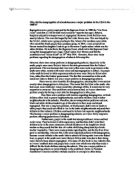There was no clear timetable for desegregation, meaning that it was unclear exactly when desegregation to take place. This meant that facilities in the south, who had racist, more traditional values could take advantage of this. It would also be very expensive to carry out. This could have easily been solved, as it was a short term problem simply by having a clear date for desegregation to take place.
Also, there was a problem with location regarding desegregation, as black children often lived in poorer neighbourhoods, and white children lived in better neighbourhoods in the suburbs. Therefore, due to transportation problems and cost, black and white children tended to go to the schools in their areas and stayed segregated. This was a long term problem, as black people didn’t earn as much as white people they could not afford to live in the better neighbourhoods and send their children to their schools. Children continued to be born into separate neighbourhoods. This became a major problem in desegregating schools, as it was a fairly long term problem affecting generations of children.
Furthermore, people in the south had strong traditional values and had racist views. They believed in white supremacy, and therefore didn’t want their children to be in the same classroom as black children or to be taught by a black teacher as they would find the idea of a white child being disciplined by a black teacher impossible. There were many protests regarding this, and the Ku Klux Klan grew in membership. I believe this is the most important problem with desegregation, because a racist attitude in the south links to schools following state laws over federal laws, as people in the south were more likely to follow state laws due to their being more likely to keep schools segregated.. The issue of Little Rock is also linked to this, as it was a southern state and people had a racist view which was why they made it difficult for the black children entering the schools. This was a major problem in desegregating schools as racist attitudes in the south had a factor in President Eisenhower’s inaction and their attitude could be an example to other states.
President Eisenhower did little to enforce segregation. He didn’t discipline the south as he was afraid of starting conflict. He wanted to keep the support of the south, as he wanted to stay president, and get the south’s vote. He did nothing to address issues today with location etc, which meant that schools were not pressured to desegregate. This is now seen as his weakest point in his time as president. This was a long term problem in desegregating schools, as he had the power to enforce segregation but didn’t take it, leading schools to believe that they didn’t need to bother desegregating schools, as no action would be taken.
Little Rock was a town in Arkansas, and was a southern town. It had started desegregating more facilities, such as parks and the police force and was therefore seen as very forward thinking and modern. It had a very successful school, the Central High School, which in 1957 decided to accept 9 black students as an experiment. The Governor Orval E Faubas was against this and announced that if the children entered the school, “blood would run on the streets”. This was to be seen to be taking a stand against desegregation as he was up for re-election. On the 3rd September, a crowd seemingly encouraged by Faubas’s words arrived to stop the students entering the school and shout at them. Elizabeth Eckford had not received the message that they should meet and enter the school together for safety reasons, and she travelled there alone, with people shouting abuse at her such as “lynch her” and “tie her to the tree”. Despite all of this Faubas still sent the state troops to the school to turn the children away.
President Eisenhower got the police to take the children, but word of this got out. The children had to be removed for safety reasons. The next tactic was for the 9 students to be taken into school by 1000 paratroopers and had a personal escort whilst at school for protection. Even when their presence had been accept school life was very difficult for them. They were taunted by teachers and student alike, yet fighting back would lead to them being expelled. This example sped up the process of desegregation, even though it was the only time that Eisenhower enforced desegregation. Reacting to this Faubas closed all the schools in the town and didn’t open them for five years. This was a short term problem, as although it was a major incident the fact that the children eventually got into the school was used as an example for other schools as President Eisenhower was seen to be enforcing desegregation.
In conclusion, even though the desegregation law was passed there were still problems with desegregation. I believe that the most important problem was racist views in the south, as this led to other issues such as the incident in Little Rock and the state government vs. federal government. It was also a factor in President Eisenhower’s inaction. An example of people in the South’s racist attitude is the Ku Klux Klan, as the organising of a violent group shows how racist they were.







